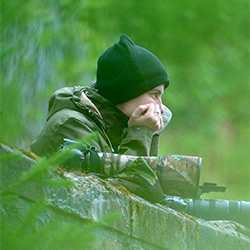 Today’s interview comes all the way from Strathbungo, Scotland and features a very talented photographer named Karen Miller. Karen carries a fondness for wildlife, especially Scottish wildlife. Karen aspires to capture the essence of wildlife in its true habitat. While out in the field, Karen makes a point of respecting wildlife in its natural surroundings. A few of the animals Karen enjoys photographing are red squirrels, otters, mountain hares, and puffins. My personal favorites of Karen’s photographs are her remarkable mountain hare photographs.
Today’s interview comes all the way from Strathbungo, Scotland and features a very talented photographer named Karen Miller. Karen carries a fondness for wildlife, especially Scottish wildlife. Karen aspires to capture the essence of wildlife in its true habitat. While out in the field, Karen makes a point of respecting wildlife in its natural surroundings. A few of the animals Karen enjoys photographing are red squirrels, otters, mountain hares, and puffins. My personal favorites of Karen’s photographs are her remarkable mountain hare photographs.
It’s my pleasure to share Karen’s thoughts and ideas about her work with my readers. Karen, thank you so much for taking the time to share your thoughts and views of nature through your words and photography and for allowing us to get to know a bit about you.
If you’d like to learn more about Karen, please visit her website and blog. You can also follow her on Twitter and Instagram.
Can you please tell the readers a bit about yourself?
I’m from Edinburgh in Scotland and after completing a degree in Modern History at The University of St Andrews followed by an HNC in radio broadcasting I have worked primarily in the broadcasting industry in a variety of roles – marketing, sales, technology, internet development, online and production/presentation in London and Scotland – radio was my first love. I currently work full-time for BBC Radio Scotland in their online team which involves updating their website as well as live music photography and filming/post-production. I also do a couple of online radio shows specialising in Americana and roots music by independent artists. You can visit the website here.
Where do you call home?
I live in a lovely leafy suburb of Glasgow in Scotland, known as Strathbungo.
After browsing through your website, I see that you’re truly immersed in the field of photography. What is it that led you towards photography and how long have you been working in it?
I’ve always enjoyed taking photographs and have owned a camera from a young age. Originally it was just point and shoot film cameras but I remember trying my Dad’s SLR when still at high-school at a tennis tournament – stupidly I manually focussed for my eyesight (I’m short-sighted) and every single photograph of greats such as John McEnroe and Jimmy Connors was very blurred!
I used to spend a lot of time photographing flowers and insects at the Edinburgh Botanic Gardens and I also enjoyed taking pictures at music events such as SXSW in Austin, Texas.
Once I finally had my own DSLR though (my first one was the Nikon D5000) I started to do much more photography, but I didn’t specialise at that time. When my brother and I were growing up most of our family holidays were spent in Scotland or the wilder parts of Northern England, and I developed a strong love for the outdoors, especially the Scottish Highlands and islands. Over the past decade, I have started spending almost all my vacation time in Scotland and can combine my love of wildlife with my love of the countryside and photography. It’s only been the last three or four years though that I’ve truly dedicated as much of my free time as possible to specifically wildlife photography. Now it’s all I ever do when on holiday and by the time I return to work I’m exhausted but happy!
Are you self-taught or formally-taught? Where have you found the majority of valuable information along your journey?
A bit of both. I attended an evening class at a Glasgow college a few years ago and over the 10 weeks learnt a lot. It was after this that I switched to manual settings on my camera. I then spent a week at the wonderful Aigas Field Centre in the highlands on a photography masterclass with Laurie Campbell, who is a brilliant teacher and expert in all things photography and nature. The week was so inspirational, and if I had to pinpoint the moment when I realised exactly where I wanted to go with photography that was it. I still hear Laurie’s voice in my head when I’m taking photographs telling me to use manual exposure, lens hoods and a tripod and although I don’t always listen it does keep me right!
I also learn from experience, workshops and looking at other photographers’ images and settings. Aside from Aigas I’ve also done a couple of extended workshops on Mull, one was general wildlife, the other specifically otters, and I picked up a lot from the guides and the other clients. Speaking to other photographers is really useful, not just for technique but to find out where to go. Many, both professional and enthusiast are very friendly.
Wildlife photography is only partly about technique though, it’s also about knowing your subject. I made the decision after the Aigas week to focus exclusively on Scottish wildlife, so that I could get to know the areas and animals. I have no interest in being a tick the box when you’ve photographed a species photographer. I read what I can on the species’ I’m interested in (I now almost exclusively read nature books) and spend as much time as I can watching and studying their behaviour – which can be fascinating.
Regarding your styles of photography, which do you prefer the most?
My aim when photographing wildlife is to take images that move me. Emotive images that capture the essence of the animal. It’s about capturing that fleeting moment. Which is why studio portraiture especially holds no interest. This obviously takes time and more often than not I return home with few if any images that do this. I really want my love of the subject to be apparent from my images. I also strive to take photographs which put the subject in context – wide-angle images can be really lovely – for example red squirrels in the ancient Caledonian pine forest in the Scottish Highlands.
Spending time with wild animals is a real privilege, they are all incredible in their own way. Much as I enjoying watching and photographing birds (I spend hours hanging out my bedroom window photographing the birds in my garden), my favourites are small(ish) mammals – mountain hares, red squirrels, otters, etc. Although I do love puffins!
I also enjoy live music and event photography for some of the same reasons – again it’s about capturing unguarded moments.

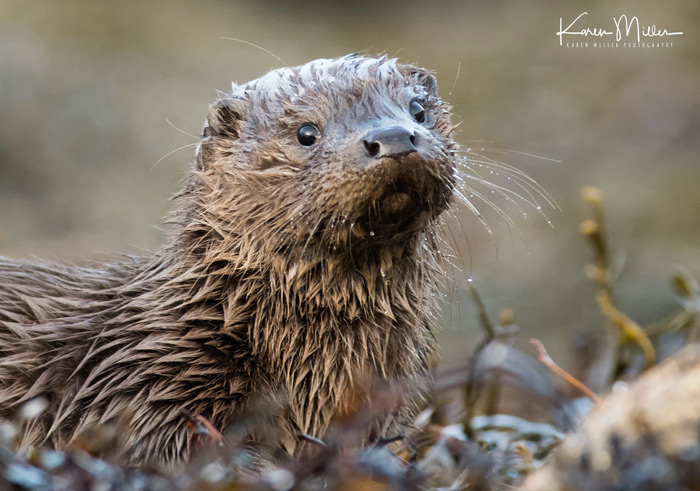
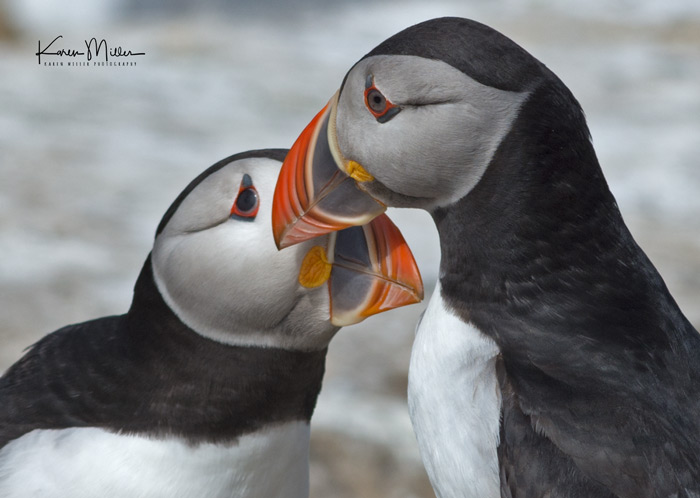
What type of photography shoots do you look forward to?
I look forward the most to photo shoots which involve no hide or bait and ideally where it’s just me and my subject, there’s nothing better. I do spend time in hides but it’s slightly less satisfying. Mostly I just look forward to settling down and observing what’s going on. Even if there is no wildlife, just being out in the countryside absorbing the sights and sounds is great.
What I dislike are locations with too many people/photographers – the Farne Islands in Northumbria is a good example of that where far too many people are allowed on the (small) island at one time and it completely detracts from the experience.
When shooting subjects, what do you find most challenging?
Wildlife is unpredictable, and even with the best planning, sometimes the animals don’t appear or are too skittish or difficult to photograph. Trying to capture interesting, emotive images of the animal can be very challenging too, they need to be relaxed in my presence (or unaware of it). …And dealing with the conditions. There’s a whole lot of rain and wind in Scotland, and although that doesn’t prevent (and can at times enhance) photographs it makes it technically much more difficult and I don’t think I’ve nailed that yet.
What’s the best part of being a photographer?
Getting away from the office-bound day job and spending time outside in the middle of nowhere with only the wildlife for company. It’s a real joy! It’s something I can do on my own and I don’t need to rely on anyone else. Discovering more about the animals I’m photographing. I witness new behaviours each time, and each photographic shoot is unique. I find now that whenever I’m outside I’m far more aware of what birds or animals are around and I’m constantly looking up into the trees and bushes to see what I can spot.
Finally, I love it when other people are moved by my photographs and my enthusiasm for the subjects. I have friends with no real interest in wildlife or photography who say I’ve actually made them pay more attention to the nature around them which is great!
What is the most challenging part of being a photographer?
Finding the time to actually get out and take photographs with limited vacation time and budget, plus a difficult dog who doesn’t travel and makes shorter day/weekend trips difficult as I need to be home for him.
Share with us your favorite image and why.
Tricky… I have quite a few images I love, mostly because they remind me of the experience. But this photograph of a rabbit has been a firm favourite ever since I took it. I’d just bought a new lens and was heading to Aigas for the photography masterclass in a few days, so popped along to my local park one evening after work to try it out. My plan had been to photograph the grey squirrels, but they kept coming too close. I then spotted a couple of rabbits on a raised platform and couldn’t believe it when one of them picked up a white feather and looked directly at me! This photograph doesn’t only make me smile whenever I look at it, but reminds me that I don’t have to travel up to the Highlands to find wildlife to photograph. I even wrote a blog about it – here

How do you keep your photography fresh and how do you stay motivated to keep on learning?
I love to learn new things and challenge myself. I think my photographs are ok but could be so much better. Looking at images taken by other wildlife photographers I see that I definitely have room for a whole lot of improvement. Technically I’m not there yet. I like to think that my photography will remain fresh so long as I continue to love what I’m doing and as my knowledge of the subjects improves so too I hope will my photographs.
Do you visit any photography related websites or blogs on a regular basis and if so, which ones?
I follow a lot of wildlife photographers on social media and it’s always informative to read their posts especially when they include details about camera settings and fieldcraft. The aforementioned Laurie Campbell has been great for this recently on his Facebook page, and often the discussion within the comments on his posts are really interesting too. I subscribe to Outdoor Photography magazine, although much of that is about landscapes which aren’t really my thing but their wildlife articles can be good. Nature TTL has some good features and I also tend to click on links to articles posted on Twitter.
What is one piece of advice you would like to offer a new photographer just starting out?
Love what you do, whether it’s studio portraiture, wildlife, sport, or any other field of photography. That love will be reflected in your images and will go a long way to helping you improve. And remember, at the end of the day it’s about enjoying what you do, especially if, like me, you’re not a professional photographer. I recently spent four miserable hours standing in a snow shower (very wet snow) in the middle of a pine forest photographing crested tits. It was horrible and I wasn’t enjoying myself at all. At times like this, I do question what on earth I’m doing this for, but actually, if I’d wanted to leave I could have, yet I stuck around because even although I was cold and my waterproofs were drenched, I’d still much rather be there, out in the open in a beautiful setting than sitting in the office updating a website.
What type of camera(s) do you shoot with? What is your favorite lens?
I have two Nikon DSLRS, the cheapest of their full frames, the D610 and the crop-frame D500. I tend now to primarily use the D500 which is brilliant for wildlife with a huge buffer and fast focusing. It also increases the focal distance of the lens which is very useful. The D610 is great for low-light though and I wouldn’t be without a full-frame camera.
Not being a professional photographer nor particularly well-off, I have pretty much reached a plateau where lenses are concerned. The two I use the most for wildlife are the Tamron 150-600mm, I have the older version of this lens and it’s great. On the D500 it gives me a maximum focal distance of 900mm. My favourite lens though is one I bought a few years ago and stopped using for a bit until the D500 came into my life, and that’s the (older version again of) the Nikkor 300mm F4 lens. It’s heavier than the newer model and doesn’t have image stabilisation but I haven’t found that to be much of a problem. Again, it’s perfect with the D500 and I often use a 1.4 teleconverter giving me a focal distance of over 600mm. I would of course like the 500mm F4, but aside from price, I don’t think I could carry it!
What is your favorite photography accessory?
I recently bought a few products from Peak Design and I love them. Their detachable camera straps and belt clip are really useful and flexible.
What piece of equipment would you most like to acquire that you don’t have yet?
There’s a new Nikon lens on the way that sounds amazing, the AF-S Nikkor 180-400mm f/4E TC1.4 FL ED VR, but there is no way I’d ever be able to afford it! More realistically the newer version of the 300mm prime would be great or an upgrade to my full-frame camera but I can’t justify either of those at the moment.
How important is Photoshop or other image editing software in your final images?
Very. I always shoot in raw and use Lightroom to import, select and do the vast majority of editing (mostly just an exposure fix). I then export my chosen images as Tiffs and do any final edits in photoshop. I tend to prefer photoshop for selective editing using layers then painting in/out the edits. I also use the Nik Effects define2 for noise reduction which is brilliant.
Can you tell me about one of your favorite or most memorable photo shoots? What made it so great and why did you like it so much?
My favourite animals to photograph are mountain hares. I don’t know if I have a specific visit to these animals that I would rate as my favourite though. I just love being on the mountainside surrounded by stunning scenery, just me and the hare – there’s no hide, no baiting, and if I’m lucky no other people around. Many of the hares on the estate I visit are okay with photographers so long as you respect them and approach slowly and sensitively. For me there’s nothing better than sitting with a hare, sometimes for a few hours, as it sleeps, grooms, grazes, and stretches. It’s a real privilege. I get such pleasure from this and from looking back at my photographs. Most of the time they don’t do a whole lot, but patience can be rewarded with some lovely pictures and experiences. On my recent visit to the highlands, I visited the hares on four days, and spent time on each visit with one particular hare on the lower slopes who was brilliant. I’ll never forget that hare and I hope it’s still in the same area when I return for a brief visit in April.
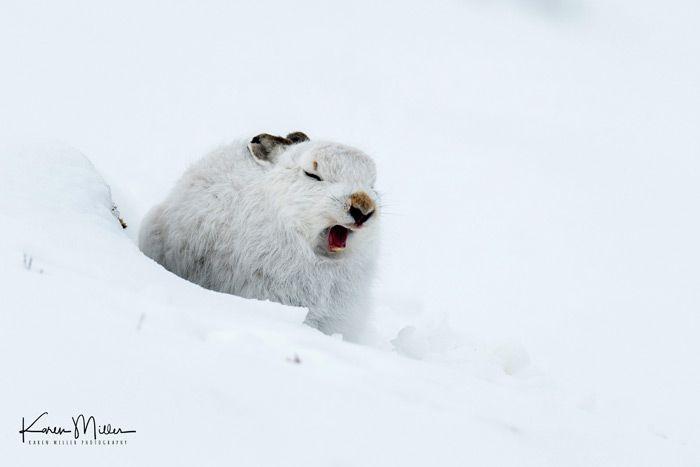
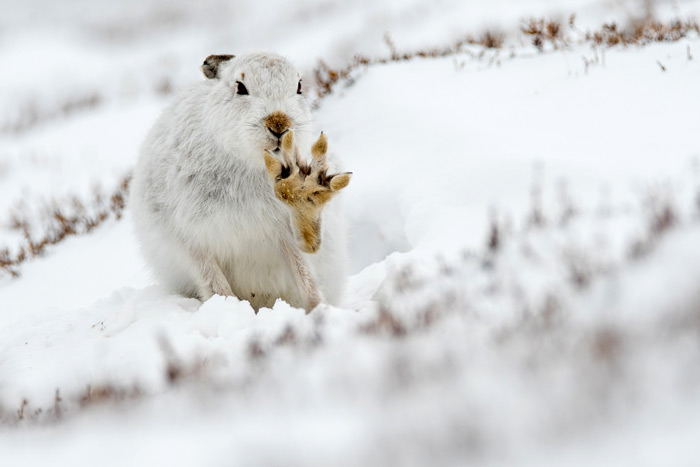
Do you have any projects that make you look back and shake your head? What made the experience so unpleasant?
I don’t think any experience is unpleasant (other than when there are too many other people). But one occasion where I was cursing myself was on Mull last April. I was spending a week on the island with my parents and I’d paid for my Dad to go on the Mull Charters white-tailed eagle boat trip for his birthday. I’ve done this quite a few times before but on this occasion, I’d lent my Dad one of my cameras and lenses and because he wasn’t a Nikon user I wanted to ensure the camera was set up correctly. However, this meant that I paid no attention to my camera or settings in advance. Once on the boat, I stupidly decided to delete all the images taken on a specific date on the memory card just moments before the eagle chose to come down for a fish right in front of me. I therefore completely missed it. It wouldn’t have been so bad if there had been a few more drops, but other settings were also wrong and I, therefore, messed up the only other drop too. I was so annoyed with myself! My dad got some photos though so it wasn’t all bad! Funnily enough, I’ve been on this boat trip 4 times over the past few years and the images from the very first trip with a cheaper camera and lens were by far the best I’ve taken! I’m back again in May and will try and do better…
Are there any areas of photography that you have yet to pick up on that you’d like to learn?
Not areas so much although I’d like to be better at macro photography, I am rubbish at that! I really just want to improve on what I’m already doing. There are also a few species I am hoping to photograph this year, namely beavers (which fascinate me), brown hares, and water voles.
What do you think the future holds for you? Where do you see yourself in the next few years?
In an ideal world, I’ll be living near Inverness in a house with pine martens and red squirrels visiting the garden! I can’t see myself becoming a full-time professional photographer, but I would like to work part-time so that I could spend more time doing what I love. I do have a few ideas I’d like to pursue if at all possible…
Leave a Reply